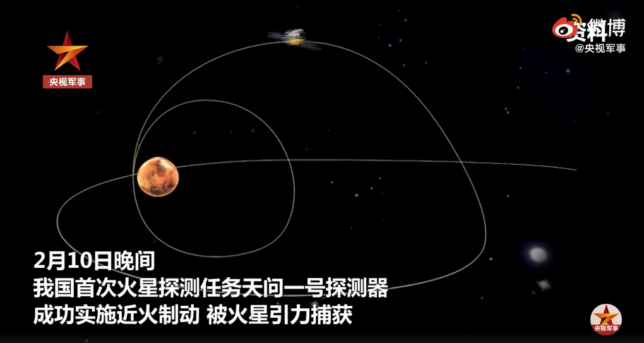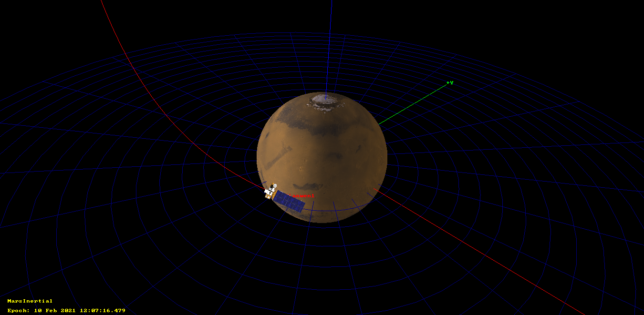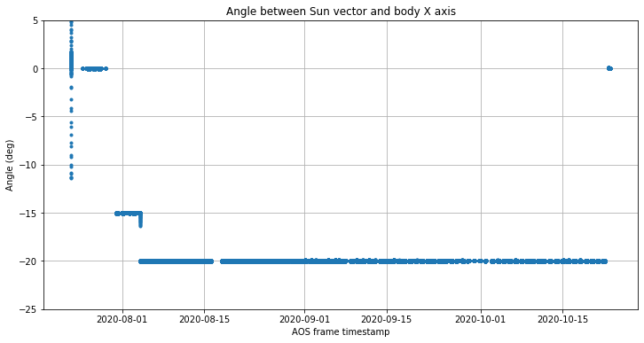Today at 9:00 UTC Tianwen-1 made its plane change manoeuvre, as reported by Xinhua. Yesterday I showed my planning for this manoeuvre. Shortly after the spacecraft returned to the high gain antenna after the manoeuvre, the Bochum 20m antenna operated by AMSAT-DL received state vectors with the new trajectory. These state vectors allow us to calculate the timestamp of the burn and the delta-V vector, as I have done in other occasions. It is convenient to remark that the state vectors that we are seeing right now are probably a prediction. In the next few days we will see updates in the trajectory as the Chinese DSN measures the effects of the actual burn and updates the onboard ephemerides.
Tag: orbital dynamics
Tianwen-1 plane change planning
Today, the Chinese media published a short piece of news stating that tomorrow, 2021-02-15, Tiawen-1 will make make a plane change to a polar orbit. The post is accompanied by an short video, which includes an animation depicting the manoeuvre. A screenshot of the video is shown below. As the spacecraft arrives to apoapsis, it effects a plane change into an ascending polar orbit.

This is a good moment to review the maths behind a plane change manoeuvre and compute what the manoeuvre will look like.
Emirates Mars Mission MOI burn observed in Bochum
A few days ago, Emirates Mars Mission (Hope), and Tianwen-1 performed their Mars orbit injection burn (MOI). AMSAT-DL made a livestream for each of the two events, showing the X-band signals of the spacecraft as received with the 20m antenna at Bochum.
In the case of Tianwen-1 the signal was pretty strong even while the spacecraft was on the low gain antenna, and we could clearly see the change in Doppler rate as the thrusters fired up. However, in the case of Emirates Mars Mission the signal disappeared as soon as the spacecraft switched to the low gain antenna. In fact DSN Now reported a received power of -155 dBm with the 34m DSS55. That was a large drop from the -118 dBm that it was reporting with the high gain antenna. Therefore, nothing could be seen in the livestream waterfall until the spacecraft returned to the high gain antenna, well after the manoeuvre was finished.
Nevertheless, a weak trace of the carrier was still present in the livestream audio, and it could be seen by appropriate FFT processing, for example with inspectrum. I put up a couple of tweets showing this, but at the moment I wasn’t completely sure if what I was seeing was the spacecraft’s signal or some interference. After the livestream ended, I’ve been able to analyse the audio more carefully and realize that not only this weak signal was in fact the Hope probe, but that the start of the burn was recorded in perfect conditions.
In this post I’ll show how to process the livestream audio to clearly show the change in drift rate at the start of the burn and measure the acceleration of the spacecraft.
Tianwen-1 Mars-centric state vectors
Since launch, Tianwen-1 has transmitted as part of its telemetry some state vector data, giving its position and velocity vector every 32 seconds. This has allowed us to propagate, track and study its trajectory. We noticed the presence of the state vector data a few hours after launch, and since then we have received and decoded this data using the 20m antenna at Bochum observatory, which is operated by AMSAT-DL. This has allowed us to supply accurate orbit information to JPL HORIZONS, so that Amateur observers (and also some professional ones, for which Tianwen-1 is a useful and strong X-band beacon) can easily get ephemerides for the spacecraft.
Until now, the state vector data has encoded the spacecraft’s Cartesian position (in km) and velocity (in km/s) in a heliocentric reference frame. It is not completely clear if the frame is supposed to be ICRF or MJ2000, since the difference between the two is very small (see Section 3.5 in this paper by Kaplan) to be able to distinguish them with the data at hand, but we have always been using ICRF so far for consistency.
Today we have noticed that starting at some point on 2021-02-08, Tianwen-1 is now transmitting state vectors using a different, Mars-centric frame of reference. We don’t have the exact moment of the change. The last heliocentric vector we received was
2021-02-07 23:23:03.744100 18791639.655712113 211029173.8782428 96492674.05965108 -21.108400067542537 4.768376820024702 1.8445381918644286
This vector was received with one of the antennas at Allen Telescope Array, which I used as a backup since Bochum was unable to track that day due to a big snowfall.
The first Mars-centric state vector was received by Bochum the next day, and is
2021-02-08 22:14:25.049300 -345203.0840200648 103420.7793506239 -15761.456419116437 2.409386271990221 -0.7794198288828312 0.12118319008153547
The change in the frame of reference is clear from the change in magnitude of the position vector. Ensuring that the Mars-centric state vectors are interpreted correctly is important to continue using the data accurately. In this post I give the assessment of the appropriate reference system to use.
Tianwen-1 TCM-4
Today, 2021-02-05 at 12:00 UTC, Tianwen-1 has executed TCM-4. This is its last trajectory correction manoeuvre before the arrival to Mars orbit next Tuesday February 10. This was reported by Chinese media together with a black and white image of Mars taken recently by the spacecraft.
As usual, I have analysed this manoeuvre by propagating forwards the last state vector that we have from the spacecraft’s telemetry before the manoeuvre, propagating backwards the first state vector that we have after the manoeuvre, and finding the intersection point of the two trajectories.
Chang’e 5 interferometric astrometry
Bill Gray, from Project Pluto is doing a great job trying to estimate the orbit of Chang’e 5 as it travels to somewhere around the Sun-Earth L1 Lagrange point (see my previous post). He is using RF pointing data from Amateur observers and the Allen Telescope Array, since the low elongation and the distance of the spacecraft have made it impossible to observe it optically.
For this task, the pointing data I am obtaining with my observations on Allen Telescope Array as part of the activities of the GNU Radio community there is quite valuable, since the 6.1 metre dishes give more accurate pointing measurements than the smaller dishes of Amateurs. The pointing data from ATA should be accurate to within 0.1 or 0.2 degrees.
To try to get more accurate data for Bill, last weekend I decided to do a recording with two dishes from the array, with the goal of using interferometry to obtain a much more precise pointing solution that what can be achieved with a single dish. This post is a report of the processing of the interferometric data.
Chang’e 5 LOI-2 observed with Allen Telescope Array
If you follow me on Twitter you’ll probably have seem that lately I’m quite busy with the Chang’e 5 mission, doing observations with Allen Telescope Array as part of the GNU Radio activities there and also following what other people such as Scott Tilley VE7TIL, Paul Marsh M0EYT, r00t.cz, Edgar Kaiser DF2MZ, USA Satcom, and even AMSAT-DL at Bochum are doing with their own observations. I have now a considerable backlog of posts to write, recordings to share and data to process. Hopefully I’ll be able to keep a steady stream of information coming out.
In this post I study the observation I did with Allen Telescope Array last Sunday 2019-11-29. During the observation, I was tweeting live the most interesting events. The observation is approximately 3 hours long and contains the LOI-2 (lunar orbit injection) manoeuvre near its end. LOI-2 was a burn that circularized the elliptical lunar orbit into an orbit with a height of approximately 207km over the lunar surface.
Tianwen-1 TCM3
On 2020-10-28 at 14:00 UTC, Tianwen-1 has made its third trajectory correction manoeuvre. This has been the next manoeuvre after the deep space manoeuvre at the beginning of October. According to the press release, this was a firing of the eight 25N thrusters intended as a minor correction and as a test of this propulsion system. I haven’t found the duration of the burn in the news.
I have followed the same method as in previous burns to compute the moment of the burn and the delta-V vector by extrapolating the telemetry orbit state vectors received by AMSAT-DL in Bochum before and after the burn. This extrapolation locates the burn at 14:02:28 UTC. Note that this time is an approximation for the mid-point of the burn.

The delta-V vector was, in m/s
[-0.6575566 , -0.11513034, 1.97535319],
and the magnitude was 2.09m/s. Assuming a mass of 5000kg and eight 25N thrusters, it would take a burn of 52 seconds to achieve this delta-V.
Update 2020-10-30: according to this news article, the duration of the burn was 42.8 seconds which is some 18% smaller than my estimate. Note that my estimate didn’t take into account the mass of fuel spent by the deep space manoeuvre, which I estimated to be 457kg (giving a decrease in mass of 9%).
Apparently this burn has lowered the periares height significantly in comparison to the trajectory following the deep space manoeuvre, which was around 18000km. Thanks to Achim Vollhardt for noticing this. It’s difficult for me to give a good estimate of the new periares height, because it is quite sensitive to orbit perturbations. I’ve obtained anything between 30 and 800 km by enabling and disabling solar radiation pressure in the GMAT propagator, and we don’t have a good estimate of the spacecraft’s cross-section and reflection coefficient.
The figure below shows one of the GMAT simulations. Note that the periares is near the equator, which is good for insertion into a low inclination orbit.

Keep in mind that according to the media still one more trajectory correction manoeuvre remains and that the data used in this post comes straight from the spacecraft’s telemetry, and as such is most likely based on a prediction of the burn rather than on the actual performance of the burn. In a few days, I will publish a new post when the Chinese DSN perform precise orbit determination and upload updated orbital information to the spacecraft.
The data and plots for this post can be found in this Jupyter notebook.
Tianwen-1 attitude change
A month ago, I wrote a post showing the evolution of Tianwen-1‘s attitude so far during its transfer orbit to Mars. For most of the mission, the spacecraft has maintained a fixed attitude where the spacecraft body Y axis was held orthogonal to the planed formed by the spacecraft, Earth and Sun, and the spacecraft to Sun vector had a constant angle of -20 degrees with the spacecraft body X axis.
The figure below shows how the spacecraft axes are labelled. Note the solar panels along the Y axis, the thruster on the -X face, and the high gain antenna on the -Z face.

Yesterday, on 2020-10-22, the spacecraft made an attitude change. The angle between the Sun vector and the X axis was changed back to 0 degrees, which was the angle maintained during the first days of the mission. This can be seen clearly in the figure below.

The angle between the Earth vector and the -Z axis (where the high gain antenna is located) is more interesting, as it gives the slew angle of the antenna. Throughout most of the mission, it was growing and I kept wondering if an attitude change would be done to prevent the antenna from running out of slew range. However, at some point the angle started decreasing. This is basically caused by the Earth “overtaking” Tianwen-1, since the Earth’s orbit is faster (you can see some pictures of this in the last slides of my talk in the AMSAT-UK colloquium).
In this graph we see that the change in attitude also causes a sudden increase of 20 degrees in this angle, so now it is 70 degrees. This shows that the possible slew range for the high gain antenna is much larger than I had initially thought. Perhaps it is not so surprising after we have seen the cut-out in the dish in the in-orbit images published on October 1.

If we zoom in to the last few days, we see that the change in attitude happened at some time when the spacecraft was not in view from Europe, so unfortunately we don’t have any telemetry of the change itself.

I’m not sure of the reason why this attitude change has been done now. It will be interesting to see if the attitude continues with this new 0 degree angle or it switches back to the previous -20 degree angle.
Thanks to AMSAT-DL‘s team at Bochum for continuing the daily collection of telemetry with the 20m antenna. Their effort makes it possible to detect events like this with short notice. The data and code to produce the plots in this post can be found in this Jupyter notebook.
Tianwen-1 DSM final trajectory
A few days ago I spoke about the deep space manoeuvre that Tianwen-1 had executed on 2020-10-09. As remarked in that post, the data we had from that manoeuvre came from extrapolating state vectors from before and after the burn. The state vectors that the spacecraft was broadcasting after the burn most likely came from a prediction rather than from the actual result of the burn. In a few days, we would see a small change in the trajectory as the Chinese DSN performed precise orbit determination and uploaded the results to the spacecraft.
In fact, we saw that change the next day. The figure below is generated in the following way. I have taken the first state vector that we have received after the burn, and propagated its trajectory in GMAT. Then I compute and plot the error in each of the ICRF coordinates between the state vectors broadcast by the spacecraft in the telemetry and this GMAT trajectory. This allows us to see whether the trajectory broadcast by the spacecraft has changed slightly at some point.

As we can see, during the first day the error is close to zero. Afterwards, the trajectory deviates and the error starts growing to several hundreds of km. The new trajectory seems to be stable over the last few days (sorry about the lack of data on the night between the 11th and 12th). This is best shown in the figure below, where the state vector used as a seed to generate the GMAT trajectory is taken from the UTC evening of 2020-10-10. The error is only a fraction of a km. Therefore, we can consider final this new trajectory.

I have updated the calculations I did in the last post to use a state vector from the updated final trajectory. The results don’t change much. The calculations now locate the burn (approximated as an impulse burn) at 15:03:54 UTC with a delta-V of
[-31.08193895, 40.28872314, 308.12845989]
in ICRF coordinates, while my previous calculations estimated a burn at 15:03:59 with a delta-V of
[-31.49477234, 39.29765307, 308.11690616]
The state vector describing the updated post-DSM trajectory in heliocentric ICRF coordinates and UTC epoch is
Tianwen1.Epoch = '10 Oct 2020 19:08:50.122';
Tianwen1.X = 172262669.5024532
Tianwen1.Y = 42536664.64589398
Tianwen1.Z = 21989467.534531824
Tianwen1.VX = -1.7753279668677469
Tianwen1.VY = 25.966616665124505
Tianwen1.VZ = 11.810575717885476